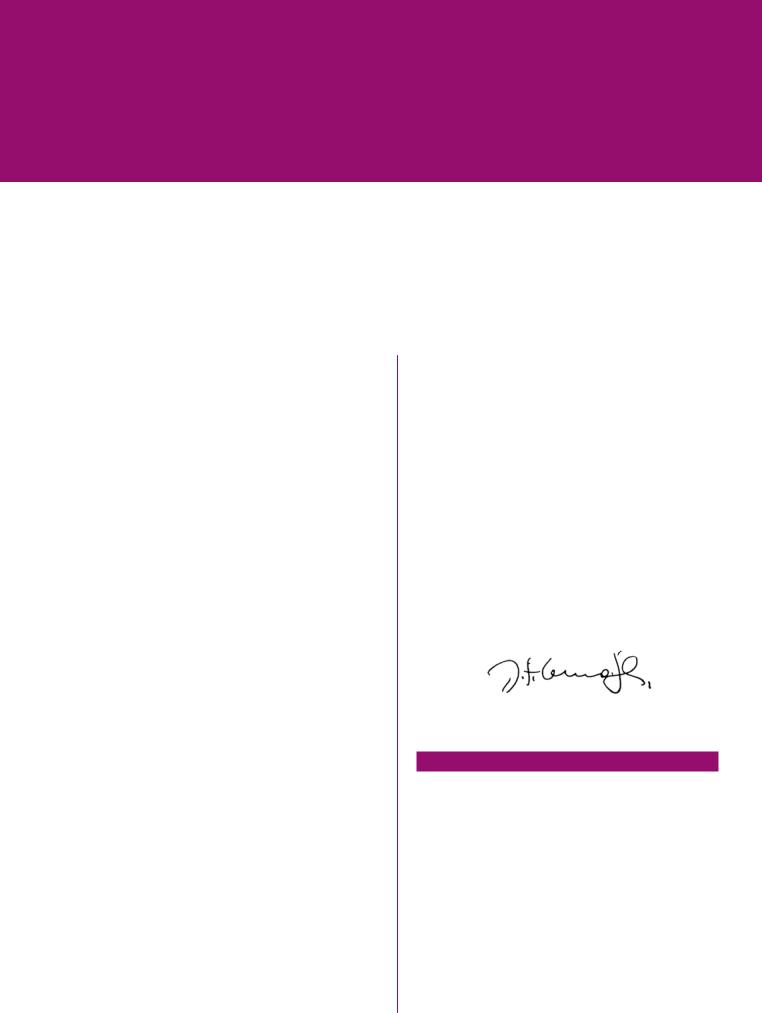
Agricultural commodity markets
.pdf
vk.com/id446425943
2018
THE STATE OF
AGRICULTURAL
COMMODITY
MARKETS
AGRICULTURAL TRADE, CLIMATE CHANGE AND FOOD SECURITY

vk.com/id446425943
This flagship publication is part of THE STATE OF THE WORLD series of the Food and Agriculture Organization of the United Nations.
Required citation:
FAO. 2018. The State of Agricultural Commodity Markets 2018. Agricultural trade, climate change and food security. Rome.
Licence: CC BY-NC-SA 3.0 IGO.
The designations employed and the presentation of material in this information product do not imply the expression of any opinion whatsoever on the part of the Food and Agriculture Organization of the United Nations (FAO) concerning the legal or development status of any country, territory, city or area or of its authorities, or concerning the delimitation of its frontiers or boundaries. The mention of specific companies or products of manufacturers, whether or not these have been patented, does not imply that these have been endorsed or recommended by FAO in preference to others of a similar nature that are not mentioned.
ISBN 978-92-5-130565-2 © FAO 2018
Some rights reserved. This work is made available under the Creative Commons Attribution-NonCommercial-ShareAlike 3.0 IGO licence (CC BY-NC-SA 3.0 IGO; https://creativecommons.org/licenses/by-nc-sa/3.0/igo).
Under the terms of this licence, this work may be copied, redistributed and adapted for non-commercial purposes, provided that the work is appropriately cited. In any use of this work, there should be no suggestion that FAO endorses any specific organization, products or services. The use of the FAO logo is not permitted. If the work is adapted, then it must be licensed under the same or equivalent Creative Commons license. If a translation of this work is created, it must include the following disclaimer along with the required citation: “This translation was not created by the Food and Agriculture Organization of the United Nations (FAO). FAO is not responsible for the content or accuracy of this translation. The original English edition shall be the authoritative edition.”
Any mediation relating to disputes arising under the licence shall be conducted in accordance with the Arbitration Rules of the United Nations Commission on International Trade Law (UNCITRAL) as at present in force.
Third-party materials. Users wishing to reuse material from this work that is attributed to a third party, such as tables, figures or images, are responsible for determining whether permission is needed for that reuse and for obtaining permission from the copyright holder. The risk of claims resulting from infringement of any third-party-owned component in the work rests solely with the user.
Sales, rights and licensing. FAO information products are available on the FAO website (www.fao.org/publications) and can be purchased through publications-sales@fao.org. Requests for commercial use should be submitted via: www.fao.org/contact-us/licence-request. Queries regarding rights and licensing should be submitted to: copyright@fao.org.
COVER PHOTOGRAPH ©West Siwa Development Project
EGYPT: Siwa Oasis is one of the best illustrations of farmers’ ingenuity to adapt agriculture to very harsh climatic conditions by managing scarce water resources to rear livestock and grow indigenous crops to respond to local needs.

vk.com/id446425943
2018
THE STATE OF
AGRICULTURAL
COMMODITY
MARKETS
AGRICULTURAL TRADE,
CLIMATE CHANGE AND
FOOD SECURITY
Food and Agriculture Organization of the United Nations
Rome, 2018

vk.com/id446425943
CONTENTS
FOREWORD
METHODOLOGY
ACKNOWLEDGEMENTS
ACRONYMS AND ABBREVIATIONS
EXECUTIVE SUMMARY
PART 1 AGRICULTURAL TRADE:
KEY DYNAMICS AND TRENDS
The evolution of agricultural trade: 2000–2016 Agricultural policy trends
PART 2
THE LINKAGES BETWEEN AGRICULTURAL TRADE, FOOD SECURITY AND CLIMATE CHANGE
Climate change, agriculture and agricultural trade
Long-term foresight analysis of climate change impacts on agricultural trade
PART 3
AGRICULTURAL TRADE AND CLIMATE CHANGE: EXPLORING THE POLICY SPACE
Paris Agreement and the World Trade Organization (WTO) Agreements
Relationship between WTO regulations and the Paris Agreement
Policy space for effective implementation of Nationally Determined Contributions (NDCs)
iv |
PART 5 |
|
|
vi |
ADAPTING TO CLIMATE CHANGE AND |
|
|
vii |
MITIGATING ITS IMPACT: THE ROLE |
|
|
OF TRADE POLICIES |
61 |
||
x |
|||
The role of trade and trade policies |
|
||
xii |
|
||
in climate change adaptation |
62 |
||
|
|||
|
The role of trade in mitigating the impact |
|
|
1 |
of climate change |
69 |
|
Assessing the policy space for trade policies: |
|
||
2 |
|
||
adaptation and mitigation in the context |
|
||
9 |
|
||
of WTO obligations |
72 |
||
|
|||
|
PART 6 |
|
|
13 |
NON-TARIFF MEASURES (NTMs): |
|
|
REGULATIONS AND STANDARDS |
75 |
||
14 |
|||
Technical Barriers to Trade (TBT) and |
|
||
|
|
||
|
environmental protection |
76 |
|
19 |
Sanitary and Phytosanitary Measures |
|
|
|
|
||
|
(SPS) Agreement |
78 |
|
31 |
GLOSSARY |
85 |
|
NOTES |
86 |
||
|
|||
32 |
|
|
|
38 |
|
|
|
40 |
|
|
PART 4 |
|
ADAPTING TO CLIMATE CHANGE AND |
|
MITIGATING ITS IMPACT: DOMESTIC POLICIES |
|
AND SUPPORT MEASURES |
43 |
Policies targeting adaptation and mitigation in |
|
production under the Agreement on Agriculture |
44 |
Policies for emissions reduction |
53 |
Assessing the policy space for domestic support: |
|
adaptation and mitigation in the context of the |
|
Agreement on Agriculture |
58 |
| ii |

vk.com/id446425943
TABLES, FIGURES AND BOXES
TABLES |
|
|
|
1.7 Average agricultural applied tariff |
4.1 Sources of growth in global |
48 |
||||
1.1 Major importers of agricultural |
|
rates, weighted average (percent), |
|
agricultural output |
||||||
|
2000–2016 |
10 |
5.1 Maize imports, 2000–2016 |
|
||||||
products: share of total import value, |
|
|
||||||||
|
|
|
|
|||||||
|
1.8 Producer Nominal Protection |
|
(billion USD) |
63 |
||||||
2016 and 2000 |
5 |
|
||||||||
Coefficient, 2000–2016 |
10 |
|
|
|
|
|||||
1.2 Major exporters of agricultural |
|
5.2 Impact of open markets on net |
|
|||||||
|
|
|
|
|||||||
|
2.1 Changes in agricultural production |
trade positions under climate change in |
||||||||
products: share of total export |
|
|||||||||
|
in 2050: climate change relative to the |
2050 |
|
65 |
||||||
value, 2016 and 2000 |
6 |
|
||||||||
baseline |
20 |
|
|
|
|
|||||
2.1 Climate change and food |
|
|
|
|
|
|||||
16 |
2.2 Baseline and climate change crop |
|
BOXES |
|
|
|||||
security |
2.1 Agricultural trade, climate |
|
||||||||
yield assumptions, percent change |
|
|
||||||||
3.1 Total domestic support |
37 |
|
|
|||||||
2011–2050 |
22 |
change and nutrition |
15 |
|||||||
4.1 Annex 2 of the Agreement on |
|
2.3 Changes in agricultural net |
|
2.2 Limitations of long-term |
|
|||||
Agriculture: Green Box support |
47 |
trade in 2050: climate change scenario |
foresight analysis |
17 |
||||||
measures |
relative to the baseline (in billion USD, |
2.3 Climate change and |
|
|||||||
|
|
|
|
|
||||||
4.2 Effects of a USD 20 tax per tonne |
2011 constant prices) |
23 |
|
|||||||
chokepoints of global food trade |
18 |
|||||||||
of carbon dioxide equivalent on |
|
2.4 Changes in agricultural production |
2.4 System drivers and scenarios |
|
||||||
selected agricultural prices for |
|
and net exports in selected countries |
|
|
||||||
|
|
in the modelling analysis |
21 |
|||||||
selected countries (percent increase) 55 |
|
|||||||||
and regions in 2050: climate change |
||||||||||
|
|
|
|
|||||||
|
|
|
|
2.5 The impact of climate change |
|
|||||
5.1 Impact of emissions leakage |
|
scenario relative to the baseline |
23 |
28 |
||||||
through trade |
70 |
2.5 Increases in exports of agricultural |
on fisheries |
|||||||
|
|
|
|
|||||||
|
|
|
|
3.1 Implementation mechanisms |
|
|||||
|
|
|
|
products in 2050: climate change |
|
|
||||
FIGURES |
|
|
|
|
||||||
|
|
relative to the baseline (in billion USD, |
under the Kyoto Protocol and |
|
||||||
|
|
|
|
33 |
||||||
1.1 World merchandise trade value |
|
2011 constant prices) |
24 |
Paris Agreement |
||||||
|
|
|
3.2 The US — Gasoline case |
39 |
||||||
and world GDP: annual growth rates, |
2.6 Decreases in exports of agricultural |
|||||||||
2000–2016 |
3 |
products in 2050: climate change |
|
3.3 Developing countries: |
|
|||||
|
|
|
|
relative to the baseline (in billion USD, |
|
|||||
1.2 Agricultural price indices, |
|
special and differential treatment |
41 |
|||||||
|
2011 constant prices) |
25 |
||||||||
1990–2018 (2002–2004=100) |
4 |
4.1 Regional food reserves |
52 |
|||||||
|
|
|||||||||
|
|
|
|
2.7 Changes in GDP in 2050: |
|
|||||
1.3 Food Price Index volatility, |
|
|
4.2 Cap-and-trade schemes |
56 |
||||||
|
climate change scenario relative |
|
||||||||
January 1991–March 2018 (percent) |
4 |
|
||||||||
to the baseline scenario |
26 |
4.3 Regulatory policies: |
|
|||||||
1.4 Evolution of South–South |
|
|
||||||||
|
2.8 Changes in GDP in selected |
|
deforestation and biofuels |
57 |
||||||
agricultural trade, 2000–2015 |
7 |
|
||||||||
countries and regions in 2050: |
|
5.1 Import financing for |
|
|||||||
1.5 Least Developed Countries: |
|
|
|
|||||||
|
climate change scenario relative |
|
developing countries |
64 |
||||||
Agricultural trade (USD billion), |
8 |
to the baseline |
26 |
5.2 The effects of global |
|
|||||
2000–2015 |
2.9 Changes in food prices in |
|
65 |
|||||||
1.6 Sub-Saharan Africa: net |
|
|
agricultural market integration |
|||||||
|
2050: climate change scenario |
|
6.1 Estimating the carbon |
|
||||||
agricultural trade (USD billion), |
|
relative to the baseline |
27 |
79 |
||||||
2000–2013 |
9 |
2.10 Changes in food prices and |
|
footprint of agricultural products |
||||||
|
|
|
|
|
|
|
|
|
||
|
|
|
|
food purchasing power in selected |
|
|
|
|
|
|
|
|
|
|
countries/regions in 2050: climate |
|
|
|
|
|
|
|
|
|
|
change scenario relative to the |
|
|
|
|
|
|
|
|
|
|
baseline |
27 |
|
|
|
|
|
| iii |

vk.com/id446425943
FOREWORD
There will be no sustainable future without eradicating poverty and hunger. Ensuring food security for all is both a key function of and a challenge for agriculture, which faces ever-increasing difficulties – as populations rise, urbanization increases and incomes grow, the agricultural sector will be under mounting pressure to meet the demand for safe and nutritious food. Agriculture has to generate decent jobs and support the livelihoods of billions of rural people across the globe, especially in developing countries where hunger and poverty are concentrated. Furthermore, the sector has a major role to play in ensuring the sustainability of the world’s precious natural resources and biodiversity, particularly in light of a changing climate.
Climate change will have an increasingly adverse impact on many regions of the world, with those in low latitudes being hit the hardest. This means that countries in Africa, Asia and Latin America, many of which already suffer from poverty, food insecurity and various forms of malnutrition, will be disproportionately at risk. Agriculture in these regions will be negatively affected. Regions with temperate climates, on the other hand, could see positive impacts, with warmer weather benefitting their agricultural sectors. Climate change can widen the economic gap between developed and developing countries. Unless we take urgent action to combat climate change, we can expect to see a very different global picture of agriculture in the future. Agricultural trade will also change.
International trade has the potential to stabilize markets and reallocate food from surplus to deficit regions, helping countries adapt to climate change and contribute towards food security. However, we must ensure that the evolution and expansion of agricultural trade is equitable and
works for the elimination of hunger, food insecurity and malnutrition globally. For this reason, in recent years, the relationship between agricultural trade and food security has become an increasing part of both trade and development agendas.
Developing countries, in particular, will need support from the global community to facilitate their adaptation and mitigation efforts in relation to climate change and to transform their agriculture and food systems sustainably. As the migration crisis of recent years has shown, no country stands unaffected. What happens in one part of the globe will undoubtedly affect other parts, and domestic and foreign policies must take account of this.
The year 2015 signalled the arrival of two landmark initiatives that recognized the need for countries to take collective action to promote sustainable development and combat climate change: the 2030 Agenda for Sustainable Development and its 17 Sustainable Development Goals (SDGs), and the Paris Agreement of the United Nations Framework Convention on Climate Change (UNFCCC). Both initiatives reflect evolving thinking around global issues, and both call for a fair and transparent international trade system. In food and agriculture, trade can play a role and contribute to meeting the targets of both the 2030 Agenda and the Paris Agreement.
The work of the Food and Agriculture Organization of the United Nations (FAO) underpins these international efforts, while also being guided by them. Through its Strategy on Climate Change, FAO delivers transformational solutions for adaptation and mitigation in agriculture at global, national and local levels. The Organization also works towards transparent
| iv |

vk.com/id446425943
and efficient global agricultural commodity markets and supports Member Nations in formulating and implementing agricultural and trade policies that are conducive to improved food security and nutrition. In this way, FAO’s work supports the discussions in the World Trade Organization (WTO).
This edition of The State of Agricultural Commodity Markets focuses on the complex and underexplored intersection between agricultural trade, climate change and food security. It is clear that we cannot tackle hunger without finding adaptation and mitigation solutions to climate change in agriculture and food systems. It is also clear that the uneven impact of climate change across regions and countries, and the corresponding changes in food availability and access will affect international trade patterns and trade routes.
Under the Paris Agreement, many countries have committed to reducing their greenhouse gas emissions, including in the agricultural sector, one of the main contributors to climate change. Collective consultations on approaches to tackle agriculture’s vulnerability to climate change were initiated in November 2017 at the Twenty-third Conference of the Parties of UNFCCC under the Koronivia Joint Work on Agriculture.
This report supports these discussions by providing an in-depth analysis of the Paris Agreement and the WTO agreements to enhance clarity and provide guidance on policy options that could strengthen the mutually supportive role of these accords in tackling climate change and hunger. Wide-ranging policy actions are necessary to ensure that trade will contribute to the efforts aimed at ensuring food security and promoting adaptation and mitigation to climate change. The uneven impact of climate change
across the world and its implications for agricultural trade, especially for developing countries, underlines the need for a balanced approach to policies, which should enhance the adaptive role of trade, while supporting the most vulnerable.
Developing and implementing policies that shift global agricultural production onto a more sustainable path, protect the most vulnerable countries and regions and at the same time facilitate the contribution of trade to the achievement of Sustainable Development Goal 2, will be key if we are to see a world free of hunger and malnutrition by 2030.
José Graziano da Silva
FAO Director-General
| v |

vk.com/id446425943
METHODOLOGY
The preparation of The State of Agricultural Commodity Markets 2018 began in March 2017. An editorial advisory board comprised of FAO specialists and external experts was formed to support the writing team. The Editorial Advisory Board reviewed, discussed and provided advice on the analysis and subsequent drafts of the report.
An International Technical Conference on Climate Change, Agricultural Trade and Food Security took place in Rome on 15–17 November 2017. The conference brought together policy-makers, academics, practitioners and other interested stakeholders from around the world to exchange ideas and share research results and experiences. The report has benefited from the research, analysis and discussions that took place at the conference. This approach significantly broadened the Organization’s knowledge and views on the issues.
To underpin the analysis in the report, climate change impacts were projected by Wageningen Economic Research using MAGNET (Modular Applied GeNeral Equilibrium Tool), a global Computable General Equilibrium model. Scenarios were developed based on trends from the Intergovernmental Panel on Climate Change (IPCC) Shared Socio-economic Pathway Three (SSP3) data and climate-related crop yields data provided by FAO.
A total of ten technical papers on several issues related to climate change and agricultural trade were commissioned from world experts to inform the writing.
The first draft was presented and discussed by the Editorial Advisory Board in March 2018 and further discussed by the FAO Economic and Social Development Department management team in April 2018. The Office of the Director-General and FAO specialists from technical divisions across the Organization reviewed subsequent drafts and the final report.
Following Members’ requests, the biennial research and publication cycle of The State of Agricultural Commodity Markets has been aligned with the meetings of the Committee on Commodity Problems (CCP). The content and findings of SOCO 2018 will be presented to the CCP at its upcoming meeting on 26–28 September 2018.
| vi |

vk.com/id446425943
ACKNOWLEDGEMENTS
The State of Agricultural Commodity Markets 2018 (SOCO 2018) was prepared by a multidisciplinary team of the Food and Agriculture Organization of the United Nations (FAO) under the direction of Boubaker Ben-Belhassen, Director of FAO’s Trade and Markets Division (EST), and George Rapsomanikis, Senior Economist and Editor of SOCO 2018. Overall guidance was provided by Kostas Stamoulis, Assistant Director-General of the Economic and Social Development Department (ESD), and by the Economic and Social Development Department Management team.
RESEARCH AND WRITING TEAM
The research and writing team was composed of: Emily Carroll, Jiyeon Chang, Luca Lodi (Data), George Rapsomanikis and Andrea Zimmermann from EST; and FAO consultant David Blandford (Penn State University).
The team received valuable comments and guidance from the SOCO 2018 Editorial Advisory Board: Boubaker Ben-Belhassen (Director, Trade and Markets Division, FAO), David Blandford (Penn State University), Joseph W. Glauber (International Food Policy Research Institute), Christian Häberli (University of Bern and World Trade Institute), Ekaterina Krivonos (FAO), Alan Matthews (Trinity College Dublin), Georgios Mermigkas (FAO), Mirella Salvatore (FAO) and Josef Schmidhuber (Deputy Director, Trade and Markets Division, FAO).
CONTRIBUTORS
Background papers
The following authors contributed with technical background papers for this report: Frank Asche (University of Florida); David Blandford (Penn State University); David Cui, Marijke Kuiper, Hans van Meijl and Andrzej Tabeau (Wageningen Economic Research); Joseph W. Glauber (International Food Policy Research Institute); Christian Häberli (University of Bern and World Trade Institute); Thomas W. Hertel (Purdue University); Lukas Kornher (University of Kiel); Ralf Lopian (Ministry of Agriculture and Forestry, Finland); C.S.C. Sekhar (University of Delhi); and Andrea Zimmermann (FAO), Julian Benda (FAO), Heidi Webber (Leibniz Centre for Agricultural Landscape Research) and Yaghoob Jafari (University of Bonn).
Additional inputs
The report was informed by the ‘International Technical Conference on Climate Change, Agricultural Trade and Food Security’, which took place on 15–17 November 2017 in Rome. The names of the presenters and background papers from the conference can be found at: www.fao.org/economic/est/est- events-new/climatetrade/en/.
From FAO, inputs were provided by Shoki AlDobai, Lorenzo Giovanni Bellu, Julian Benda, Denis Drechsler, Günter Hemrich (Deputy Director ad interim, Nutrition and Food Systems Division), Alexander Jones (Director, Climate and Environment Division), Aikaterini Kavallari, Michelle Kendrick, Ekaterina Krivonos, Brent Larson, Yasaman Matinroshan, Georgios Mermigkas, Mirko Montuori, Jamie Morrison (Strategic Programme Leader, Enable inclusive and efficient agricultural and food systems),
| vii |

vk.com/id446425943
ACKNOWLEDGEMENTS
Marc Mueller, Zitouni Oulddada (Deputy Director, Climate and Environment Division), Clarissa Roncato Baldin, Stefania Vannuccini, Ramani Wijesinha Bettoni, Trudy Wijnhoven and Jingyuan Xia (International Plant Protection Convention Secretary). Fabio De Cagno and Chiara Di Domenico provided administrative support. Araceli Cardenas, Raffaella Rucci and Ettore Vecchione provided support on communications issues.
Translation and printing services were delivered by the Meetings Programming and Documentation Service (CPAM) of the FAO Conference, Council and Protocol Affairs (CPA) Division.
The Publishing Group (OCCP) in FAO’s Office for Corporate Communication provided editorial support, design and layout, as well as production coordination, for editions in all six official languages.
THIS REPORT
The 2018 edition of The State of Agricultural Commodity Markets aims to deepen the discussion on the broad spectrum of policy instruments available to policy-makers implementing the Paris Agreement. It examines how various forms of domestic support and trade measures relate to climate change adaptation and mitigation; how they might be used in the future; and, how World Trade Organization (WTO) rules shape policy choices.
The report explores policy options that lie on the juncture of: the Paris Agreement, a framework that allows flexibility in setting targets and choosing interventions; and the WTO agreements, which are based on specific rules aimed at minimizing production and trade distortions. As such, it discusses how best to strengthen the mutually supportive role of these multilateral accords.
The report is organized as follows:
Part 1 focuses on the evolution of agricultural trade, its structure and patterns during the period 2000–2016. Understanding the dynamics and trends that drive changes in the pattern of agricultural trade is key for analysing the likely effects of climate change on global agriculture and the linkages between trade and food security.
Part 2 describes how climate change affects agriculture and food security, and how agricultural trade and related policies can contribute to adaptation. It adds to our understanding by providing projections of the likely impact of climate on agricultural production and trade by 2050, highlighting its uneven effects across regions and countries.
Part 3 discusses in depth the interlinkages between the Paris Agreement and the WTO agreements, especially the Agreement on Agriculture. By focusing on their underlying principles, as well as the mechanisms that govern their implementation, the analysis demarcates the policy space within which countries can act, but also identifies potential difficulties.
| viii |
